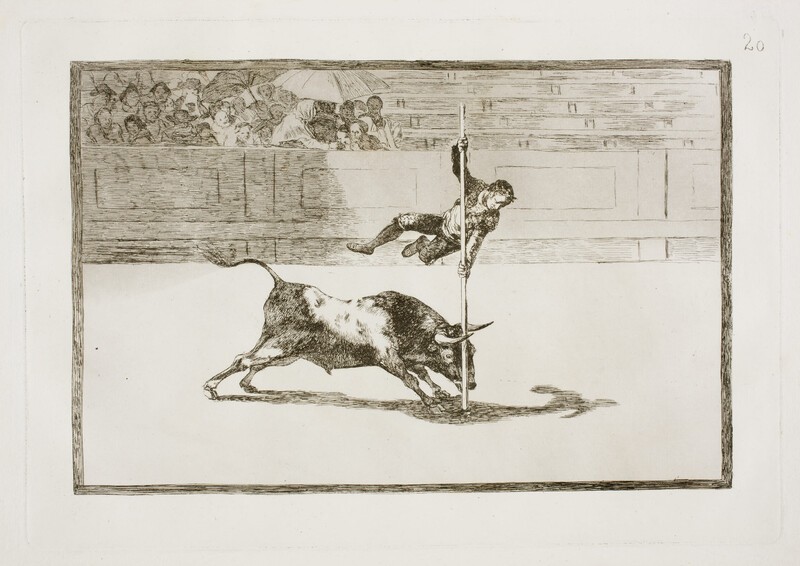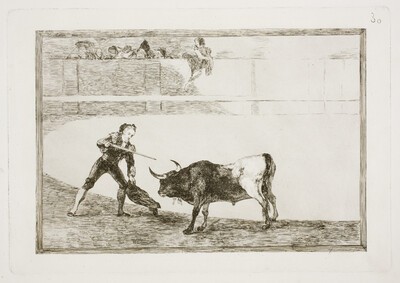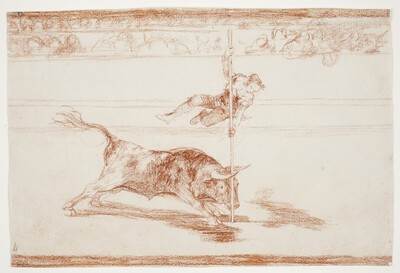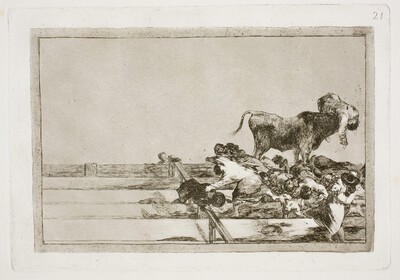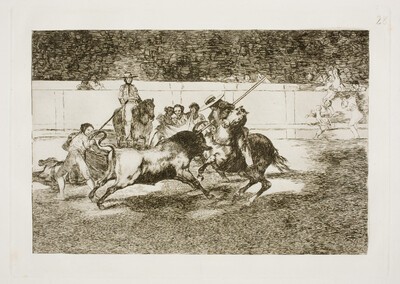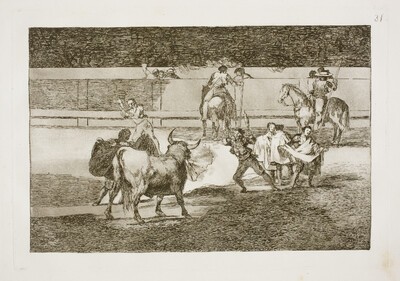- Cronología
- 1814 - 1816
- Dimensiones
- 245 x 353 mm
- Técnica y soporte
- Etching and aquatint
- Reconocimiento de la autoría de Goya
- Documented work
- Ficha: realización/revisión
- 02 Oct 2021 / 22 Jun 2023
- Inventario
- -
20 (print, upper right-hand corner)
See How the ancient Spaniards hunted bulls on horseback in the countryside
The plate is kept at the National Chalcography (nº 353).
See How the ancient Spaniards hunted bulls on horseback in the countryside
This is one of the most important prints in the Bullfighting series, above all because it is one of the ones that best reflects the idea of movement. In fact, the moment when the Riojan bullfighter Juanito Apiñani flies over the bull hanging from a pole between the animal's horns in front of a half-full arena is undoubtedly one of the culminating and iconic scenes of Bullfighting. It is also notable for its balanced composition, focusing on the main group formed by the bull and the bullfighter in the centre, and for the masterly transmission of the sensation of suffocating heat, which is achieved through very intense lighting using the white background of the paper, but also through visual devices such as crowding the spectators attending the bullfight on the left-hand side of the composition, This generates a very marked contrast, as one part of the print is visually very full and the other very empty, and conveys the idea that they are fleeing from the sun and the heat, an idea that is reinforced by the inclusion of two figures carrying sunshades to protect themselves from the sun.
The scene, due to its immediacy, seems to have been captured by a photographer, a fact that has been underlined by several authors, who have also pointed out that Goya was probably a privileged witness to the feat evoked. Luján comments that the fact of contrasting the right-hand side, without figures, with the left-hand side, which is crowded, makes the whole more suggestive and contributes to the movement of the picture. It is precisely this visual device of grouping the figures in the stands in a single area, all crowded together, that Goya would use again, although with very different dramatic overtones, in the next print in the series, Disgraces in the Madrid bullring and the death of the mayor of Torrejón, another of the most outstanding prints both for its subject matter and its composition.
Glendinning refers again, in the case of this engraving, to his theory of distorted faces, the use of which in his opinion would imply a criticism of those who participate, in one way or another, in a bullfight, as in other prints in the series such as Martincho's Fearlessness in the Zaragoza bullring, The Struggling Rendón Stinging a Bull Whose Luck Killed Him in the Madrid bullring or Flaming Flags.
Holo, on the other hand, highlights the masterly lighting effects created by Goya, which draw attention to the main action. Thus, the crowded arena is darkened while the empty part is illuminated, as is the bullring, where the main action takes place. Only the bull and the bullfighter jumping out of the ring are in slight shadow. Through this use of light, the author relates the print to another in the series, Pedro Romero killing a standing bull.
It is also worth mentioning that Martínez-Novillo, in relation to this engraving, which he considers masterly, praises Goya's capacity for classicism, composition of forms and balance.
There is a preparatory drawing of this print, also entitled Lightness and Daringness of Juanito Apiñani in the one in Madrid.
-
Grabados y dibujos de Goya en la Biblioteca NacionalBiblioteca NacionalMadrid1946catalogue Elena Páez Ríos
-
Goya en la Biblioteca Nacional. Exposición de grabados y dibujos en el sesquicentenario de su muerteBiblioteca NacionalMadrid1978May - June 1978
-
Grabados de Goya: colección propiedad de la Biblioteca Nacional, que se conserva en su Gabinete deCasa de la Amistad de MoscúMoscow1979exhibition displayed from January 18th to 31st 1979
-
1984
-
Madrid1987
-
Madrid1990
-
Goya grabadorFundación Juan MarchMadrid1994consultant editors Alfonso E. Pérez Sánchez and Julián Gállego, from January 14th to March 20th 1994
-
Goya grabadorMuseo del Grabado Español ContemporáneoMarbella1996from March 8th to May 5th 1996
-
Zaragoza1996
-
Ydioma universal: Goya en la Biblioteca NacionalBiblioteca NacionalMadrid1996from September 19th to December 15th 1996cat. 289
-
Schlaf der Vernunft. Original radierungen von Francisco de GoyaMunich2000
-
Madrid2002
-
Madrid2002
-
Goya en tiempos de guerraMuseo Nacional del PradoMadrid2008consultant editor Manuela B. Mena Marqués, from April 14th to July 13th 2008cat. 152
-
Bilbao2012
-
Goya et la modernitéPinacothèque de ParisParís2013from October 11st 2013 to March 16th 2014cat. 32
-
Goya: Order and disorderMuseum of Fine ArtsBoston2014cat. 136
-
Zaragoza2017
-
1946pp. 177-216, espec. p. 199
-
BarcelonaTartessos-F. Oliver Branchfelt1946 (reed. 1951)
-
1961pp. 120-127
-
OxfordBruno Cassirer1964vol. II, 1964, p. 335, cat. 223
-
Vie et ouvre de Francisco de GoyaParísOffice du livre1970p. 278, cat. 1190
-
MilwakeeMilwaukee Art Museum1986pp. 19, 20, 24 y 32
-
Goya, toros y torerosMadridMinisterio de Cultura, Comunidad de Madrid1990p. 103, cat. 35
-
MadridCaser-Turner1992p. 32
-
Catálogo de las estampas de Goya en la Biblioteca NacionalMadridMinisterio de Educación y Cultura, Biblioteca Nacional1996cat. 341
-
Ydioma universal: Goya en la Biblioteca NacionalMadridBiblioteca Nacional, Sociedad Estatal Goya 96 y Lunwerg1996p. 255
-
MadridMuseo Nacional del Prado2001pp. 74-76
-
MadridMuseo Nacional del Prado y Ediciones El Viso2008pp. 428-429, cat. 152
-
ParísPinacoteca de París2013p. 107
-
Goya: Order & DisorderBostonMuseum of Fine Arts Boston Publications2014pp. 216-217
-
Goya. In the Norton Simon MuseumPasadenaNorton Simon Museum2016pp. 186-201
